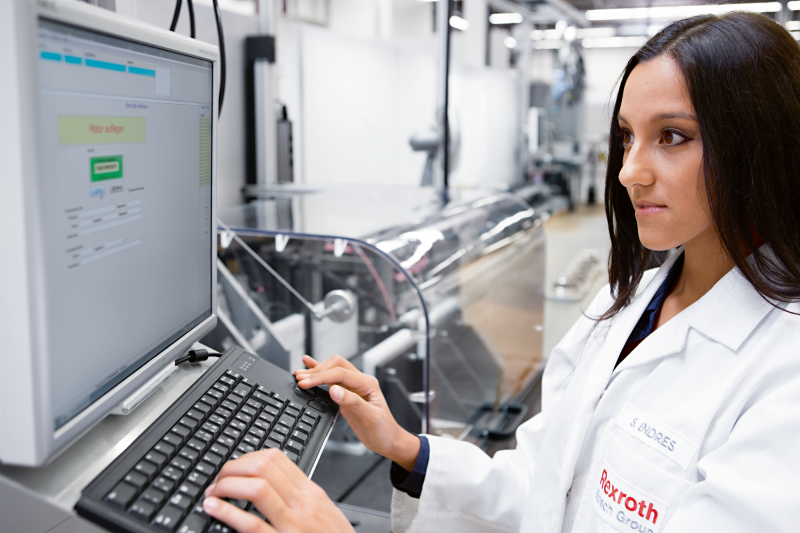
…the restraints of hardware – the software of the future. Let’s talk about math for a minute: You once used specialized hardware to do your arithmetic for you – namely, a pocket calculator. Today, you let your notebook, smartphone or even Alexa handle the number-crunching. State-of-the-art automation technology is borrowing from this trend: Developing functions exclusively for special device platforms that are produced in relatively small numbers is becoming an increasingly uneconomical proposition. In the factory of the future, machine modules and processing stations will be regularly reorganized, flexibly take on new tasks and retrieve the appropriate software function. This change has already begun: Machine manufacturers are already able to install identical control functions on various device platforms without any extra effort. Here is an overview of concepts for today and tomorrow:
Flexibility without the control cabinet
The software functions of smart drives can perform complex tasks with the help of integrated technology functions and take some of the load off of superior control systems. This form of intelligence is used by both conventional drives and drive technology without control cabinets in which the power and electronic controls are integrated directly into the machine. With the help of this principle, machine manufacturers can modularize even more than before by operating modules and machines separately from one another. Users will save space and can flexibly arrange machinery and systems to create new configurations over and over again…
…The connected hydraulic system is already using this approach. Axis controllers without control cabinets decentrally complete the control loop in such places as a steel works or paper factory. This saves cabling and brings the intelligence directly to the site – regardless of the drive technology.
At the human/secure fittings interface, local software facilitates correct and documented execution. The control and power electronics are integrated into the latest generation of cordless nutrunners. As a result, the fittings are also applied in the radio shadow in a process-secure manner. The integrated control system buffers the screw result and transfers it wirelessly at a later time to the receiving station.
Totally classic: embedded
The software is the same, even if things get rough. Embedded control systems that are frequently tucked into control cabinets are protected to a large degree from jolts, vibrations and other environmental influences. They currently cover the middle and high performance range. Like all established middle-class technologies, they go head to head against alternative concepts, including drives without control cabinets and…
… independent hydraulic actuators. Servo-hydraulic axes have their own decentral fluid loop, a variable-speed pump drive and a firmly attached cylinder. They do not require a central hydraulic power unit. The trick: The same drives with identical electronics in the control cabinet are used for energy-efficient, closed-loop speed control. No special hydraulic knowledge is needed for commissioning because the software guides the technicians, and wizards suggest the appropriate parameters.
Power made easy
High-power industrial PC solutions. They are frequently used when wide-ranging process data have to be prepared along with the actual motion control. For instance, IPC-based solutions with data-intensive camera images can evaluate the quality of each individual workpiece and initiate processing steps in real time. A tremendous amount of time can be saved in such demanding processes if the automation only has to be parametrized.
Even linear motion technology, something that appears to be entirely mechanical, has entered the digital age. In addition to position, sensors in the guide carriages measure temperature and acceleration. As a result, they can provide critical data about the state of the components and the entire system. Such data can be processed and then forwarded to the control system or to a higher-ranking position. Users can develop optimization ideas from this information and do such things as recognize wear and tear at an early stage and act before a breakdown occurs.
Software on demand – from the server
The concept of distributed intelligence is increasingly being enhanced with functions stored on servers. The first projects are already under way. In them, functions can be retrieved from a master computer at the production line, that is “on edge” – regardless of the control hardware being used there. To systematically apply this concept, automation functions should ideally be programmed in high-level IT languages. An app-based software architecture is possible only if it can access the control cores of all devices platforms simultaneously to SPS.
Here, too, reality is much farther along than many suspect. Interactive communications platforms set up directly on the production line collect all relevant data, analyze them and visually process them in real time for employees. Employees can immediately spot deviations and can initiate the appropriate corrective measures. And best of all: Employees do not need to have any programming knowledge in order to adapt the platform to their special needs.
The connection of manual work and software functions is reflected in a very practical way by smart work stations for multifaceted manufacturing. The workpieces to be assembled identify themselves by using RFID, and the station retrieves the appropriate work plans from a superior system. Users apply this basis to dock the widest range of assistant systems that visualize the work instructions and describe them in the employee’s preferred language. Places of installation and the corresponding attachment parts can be marked with light, and work steps can be directly reviewed. While assembly is under way, work preparation is creating work procedures for other products and places them on the server.
Next stop: Cloud
The latest step is to migrate the software functions to the cloud – it involves the identical software that runs on a smart drive system. Devices around the world can access required functions – and very soon wirelessly. The new 5G standard will deliver the required stable transmission rates. A pipe dream? Just how long has it been since you once bought programs on DVDs for your private use and installed them on your PC?




 Germany
Germany